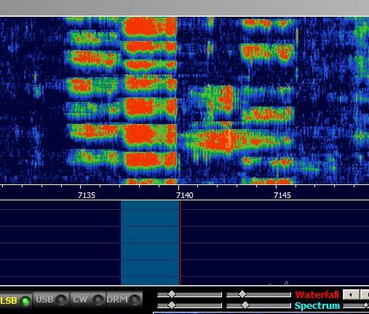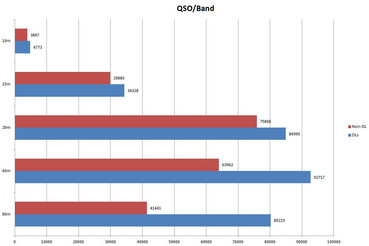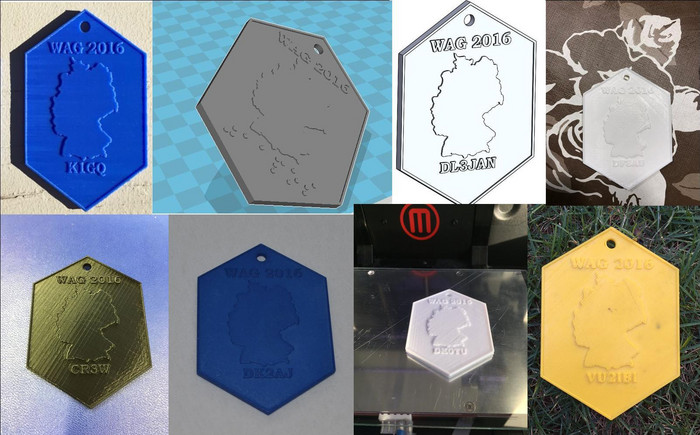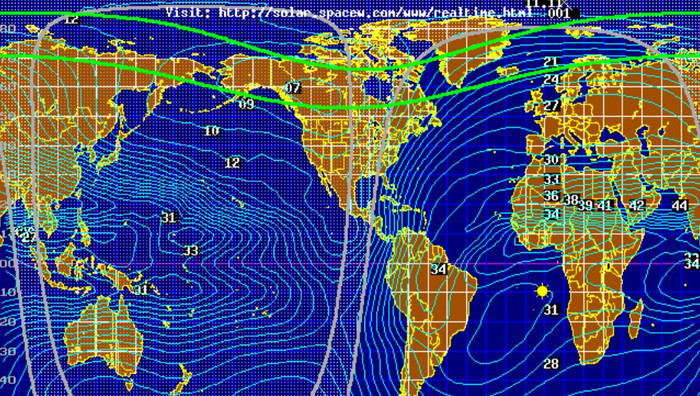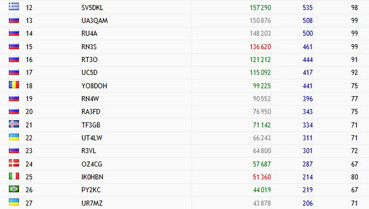Report 2016
Final Results of WAG 2016 are ready
It's time for the after xmas presents: The final results after logcheck (link in the title). The check resulted in average deduction of nine percent of the submitted raw scores - only a tiny bit more than in the two previous years when it had been 8,7 and 8,9 percent (description of our logchecking process here).
Logging accurately is one of the basic contest skills besides fast operating: The group of TopTen ranked stations lost only 3,7 percent in average. And it decided one prestigious German title: In the multioperator category DR1D led initially with raw score. After logcheck they lost the win to defending champion DL1A. They lost only 4,1% while for DR1D deductions summed up to 8,3%.
Saint Cluster, speeders and special DOKs took their toll
They come close to Saints or even the Oracle of Delphi: Spots from the cluster or the RBN network. But embarrassing when they are used too lighthanded: AP2IA called CQ on 15m, ran his pileup patiently, got spotted, worked even more stations, went QRT then. A few seconds later SV1... took over his frequency, called CQ, worked stations, identified continuously with a loud signal - only to be logged on and on as AP2IA as faithfully copied from the bandmap...
The contest jungle was populated as usual with even more QSO predators: When CR6K speeds across the bands with 40WpM not all are up to cope with - and to copy. 145 of his QSO partners (in >1500 contacts) lost the QSO. The speeding station does not loose the QSO as we only deduct for the stations in error - some of which may have not dared to ask for a repeat of call or serial. One of the most friendly predators are special DOKs of German stations. DK0HR happily spread and sent its jubilee DOK 50F32 - only to be logged by nearly one third of the worked stations with F32. This is their regular DOK and stored in the many so trustworthy "databases".
Narrowband SSB still not invented...
More serious are deductions for QSOs in the contestfree segments. Overall situation looked reasonable, but 40m remains the problemzone during Saturday afternoon/evening. Many contesters are reluctant to use the "lower" segment from 7060 to 7080, so pressure is high between 7140 and 7200. We do random checks of the contestfree segments with our SDR recordings and delete all QSOs detected there. That also hit some ops with the optimistic hope for their LSB signals on 7140 were narrow band. But it looks like on the picture and our rules repeat the fact that the sideband is the signal.
Around 650 QSO lines (=0,1% of QSO-lines in database) from the contestfree segments were lost representing about 350 two-way-QSOs. Last year we had a bit more than 300 QSO lines.
It may be partly due to the fact that condx allowed less on the higher bands thus increasing congestion on especially 40m.
Glass half filled or half empty?
Compared with the weeks before WAG and most of the weeks after WAG - we could have been hit much harder by condx. Even 10m forced itself to some extent to deliver QSOs even it was not runnable from most DX locations. From most: FY5KE (piloted remotely from Paris by F6FVY) made good use of the available condx. His 68 10m-QSOs with 22 multipliers could not be compensated by his Europeam competitors on the low bands.
How many? Who disappeared?
Attention: Now it's time for numbers - and inbetween a few pictures of stations and ops.
2080 logs submitted (five percent below record year 2015) with
549399 QSO lines (=224 QSOs per foreign participant and 320 per each DL op) from
100 DXCC-/WAE countries
1031 logs from Germany (nearly unchanged) and 1049 from abroad
98 kilo would have been their total weight if printed on paper
European Russia was the most active DXCC, followed by the US and Ukraine
Most active district in Germany was Saxony (district S) with 86 logs and 35127 QSOs, this time with a big margin to runner up Thuringia (X) with 73/25760 and Hesse (F) with 68/21305.
Most rare districts were U, L and Q with each less than 5000 QSOs
2770 active DL-calls (2014 with at least 2 QSOs) from 860 different DOKs (explained here) made for your pool for activity
In the picture gallery: MultiOp Team DK0TU in Berlin (1); QTH of YL's contest workshop of DARC districts O and N (2); Tweet by DD0UL claiming winning chances after second QSO with antenna which may win title as smallest wire used in WAG (3); picture tweeted by DG2RON from our neighbours on the bands from scout's JOTA (4); more infecting of youth with radio at DK5TX (5); a few of contesters' most important gadgets at DL3DW (6); setup at YO7CKQ (7); relaxed Savas 9H1AE making 336 QSOs (8); operating DM6A during night on ship (9); SV1JG (10); DG2BCA as Op at DF0BRA (11); Wilf, DJ6TK (12); contest corner @ DL1CW (13); soundcheck @ DL1RF (14); EA2CW (15); tasty version of DL5L (16) and screenshot snippet of Livescores which provides instant score update during the contest for those who connected to this service (with 130 more than the 117 in 2015).
Best "Golden Logs" from Scandinavia
88,5 percent of QSOs could be directly checked against the corresponding logs (exactly the same value as 2015)
6722 calls of the intial 11651 survived the logchecking procedures
5843 comment lines were investigated and manually added to save and delete QSOs beyond the scope of the crosscheck done by software
182 logs contained not one error to reach "Golden Log" status. The biggest of them with 483 QSOs came from OG6N, followed by SM6EWB (347) and RA3FD (343). Best German "Golden Log" was submitted by DL5ALW (303), followed by DL6HCC (207) and DK2TC (130)
79271 minutes was the cumulated operation time of all WAG participants submitting a score for a category = 553 days
7 hours is the average op time (8,1h for German ops and 6 hours for foreign ops)
Our "Thank You"-experiment
It is quite incredible how many ops even from remote parts of the world (distantwise seen from DL) participated and added QSOs to this activity. Therefore we wanted to not only say "Thank You" here but to add a bit more. We tested a little innovation for that purpose: Nearly 1000 participants received a little medal with their call - as a file. These STL-files can materialize into the medal from a 3D-printer. Using different materials and colours they allow for many different and individual versions, one call came even in Braille characters (thanks 3d-activation.de)
Do we need to understand everything and everyone?
For example an op who sent the following "serial" numbers in his four QSOs:
010, 100, 001, 101 - our deciphering engine is still running ;-)
The op who sent in his one single WAG QSO "serial" number 2254 (SDR confirmed)
The somewhat heroic effort to send a still not copied H in CW such:
dit - pause - dit - pause - dit - pause -dit
An op being friendly asked whether he wants to submit a log answering like: "After the check in contest XY I will never again submit a log and I'm happy to worsen the quality of adjucation."
Why DG500BIER (=beer) didn't send 59 PROST (cheers)
End titles & credits ;-)
Repairs & Investigation
Heiko, DL1RTL
Klaus, DL1DTL
Axel, DL6KVA
IT-Unit
Franta, DJ0ZY
Info Hotline
Arno, DL1CW
Log collectors
Jan, DL5JAN
Uwe, DL5ALW
Stefan, DL4FNM
Quoting DK8NT: "Thanks, world, for working us!"
See you all 2017 (21/22 Oct)
Chris DL8MBS
WAG Contestmanager
WAG 2016 - first impressions
That was not to expect: Sun and ionosphere gave the best they could at this point of the solar cycle. It would not have been a surprise if 10m or 10m and 15m would have been deserts of noise. But they were open and thanks to participants from around the world German stations could hunt for DX and you possibly had quite a few Germand stations to hunt - with all kinds of DOKs. At least we heard a few rare and some very demanding DOKs from the receiving stations point of view... And here is what the MUF looked like on both afternoons.
Especially some WRTC aspirants were among the first to break the 1000 QSO mark, some ops already early Sunday like CR6K, UA2F or IS0/OM2VL,LZ8E. Some more like LY4L, SK3W or HA9T are to be expected is this range, too, to mention only some. This year again more stations joined the fun with livescores posting their actual score online. But of course the 130 stations having logged in are only part of the game. We will present raw scores (unchecked) of all participants in early November, few days after deadline for log submission.
Usual disclaimer about our most mysterious multiplier: The letters in the DOKs stand for DARC districts (and Z for club VFDB), but there is no district J in DARC. Only by working clubstations which have special DOKs starting with J (mostly from youth departments, because J stands for "Jugend"=youth) you can bag the rare J multiplier.
Participation was a bit down from the record year 2016 but did not suffer in longrange comparison: On Sunday before deadline the number of submitted logs crossed the mark of 2000, something we had experiend before only in 2015. And another positive: Log quality is up - we hade comparatively fewer cases of logs needing serious repair :-) But of course individual times and the like kept us busy.
We will keep you up to date with whats happening now as long as we collect logs and later start the logcheck after the deadline. For now: Many thanks and finally some first impressions sent by our participants on the many different online channels.
Can we use RBN spots to detect power cheating?
Bigger No and smaller Yes.
As we deal with spots, here are our spots of experience gathered by wading through zillions of spots during WAG.
The unknown variable: Other than common perception RBN spots do not deliver a value for signal strength but for signal to noise ratio S/N. N is an always unknown variable in the equation.
Single spots can be more than spotty: As an extreme we found a minute in which one station generated two spots at the same skimmer with both spots differing 13 dB. There was also one skimmer producing the 250 highest values amongst all German skimmers ranging from 55 to 99dB. Investigation revealed that erratic behaviour was caused by RF produced at that QTH by the skimmer owner when he operated himself.
Skimmer vs Skimmer: Their values in absolute numbers can not be compared against each other. One German 100W station generated the following average values at German skimmers during several hours of activity on 80m:
Skimmer | Distance (km) | Avg. S/N (dB) |
A | 485 | 20,2 |
B | 438 | 15 |
C | 416 | 32,1 |
D | 406 | 17,7 |
E | 397 | 17,7 |
F | 365 | 27,5 |
G | 322 | 25 |
H | 275 | 33,3 |
I | 266 | 14,3 |
J | 11 | 15,7 |
So the S/N values are also not easily related to distance between TX and skimmer.
Also the patterns of that RBN skimmers do not match exactly. In a graph the lines connecting measured values of one station during the course of time do not always run in parallel. An increase at four skimmers might not be represented in the same amount or at all at the fifth skimmer.
Averages: Such somewhat shaky patterns also emerged when we did a test from the same QTH/antenna with 100W vs 700 Watts. Each single skimmer did not show exactly the 8,4 dB. But: The averaged values of these skimmers showed 8,2 dB difference. It was one of the first “Ooooops”-moments reminding why averages are a serious method in most research from biology to social scienes.
The checks concentrated on values of German skimmers. Such were their averages for a German TopTen group in high power on 80m:
DL1XYZ 34,8
DL2XYZ 34
DL3XYZ 33,8
DL4XYZ 31,3
DL5XYZ 30,1
DL6XYZ 27,7
DL7XYZ 25,7
DL8XYZ 25,9
DL9XYZ 24,1
DL0XYZ 22,7
Especially station DL0XYZ sticked out. Asked about the observed low value the operator replied that he had to throttle the output on 80m to about 300 W due to RF issues. Legal limit would have put him in the 26 dB group fitting to the other stations. Oooops again. Big numbers do not lie completely.
Next step was to generate average values per band for different stations including their distance to central DL or the average distance to the used skimmers. The tables looked intriguing at first look. But how reliable are they? One has to take into account that the stations operated at different moments on that band and used different frequencies.
Slices of time slots: Next step then was to zoom in from total average to averages for shorter time slots to adapt i.e. for varying condx during the contest. With most RBN setups we have only one spot every ten minutes per each skimmer. Used were averages from five skimmers for each time slot. They showed mostly a span of 4 to 6 dB between highest and lowest value of the time slots for a given station. This may be attributed to either varying condx or different noise situation on each of the several frequencies.
One can also group the slices of several stations calculated in chronological order to compare them at comparable times. It looks such with the right table being sorted by call:
Beams: Most of the work was done on 80m and then 40m with German and EU stations. It should minimize the influence of skip zones where few kilometers difference can mean an abrupt loss of signal strength at the target region, and it should also minimize the influence of beam directions.
We checked that with two EU stations in more than 1000km distance whose beam directions to Germany differed about 90 degrees and calculated their average S/N values at some European RBN skimmers on 15 and 20m "behind" Germany. With four of five choosen skimmers we earned a nearly exact difference of 13dB between the two stations when one had the skimmer in the main lobe and the other station had the skimmer about 90 degrees off. But as it is still with RBN analyzes: The fifth skimmer gave an opposite result favoring the sidelobe value over the near main lobe value.
Short summary: There is insight, value and potential in RBN figures. But they will require a lot of work still to be done if we want to use them as a serious “forensic” tool on which hard measures like DQs could be based – if it comes to single digit dB figures.
One task is to evaluate the quality of spots delivered by RBN skimmers which may result in choosing only a selected numer of somewhat “certified quality skimmers”. Next is sober statistical work to eliminate clearly erratic values. Then we need some on air validations with different power levels and the respective RBN response. The same is necessary for comparing different antennas at the same QTH at constant power level.
We also do need more spots than only from 10 minute intervals to improve the sampling rate.
Thus ending this summary with thanks to DL1RTL and DL6MHW for tests plus thoughts and input.
Of course we could also try to gain real signal strength values from SDRs.
The big “but”: Do we really want to do this? Power cheating is the equivalent to doping in sports. Once our analytic tools are at or near a level to be used for adjucating we will experience the same as sports have experienced: A shower of most creative antenna and condx theories and generalized anecdotes will pour down. All those “I once worked the antipodes with five watts, so you can not rule out that...” or “The ground properties at my house are soooo much different...” will be experienced like all the creative metabolism theories and stories about ominous steaks with hormones eaten in an odd tavern on the roadside which all have been heard in professional sports.
(de DL8MBS)

